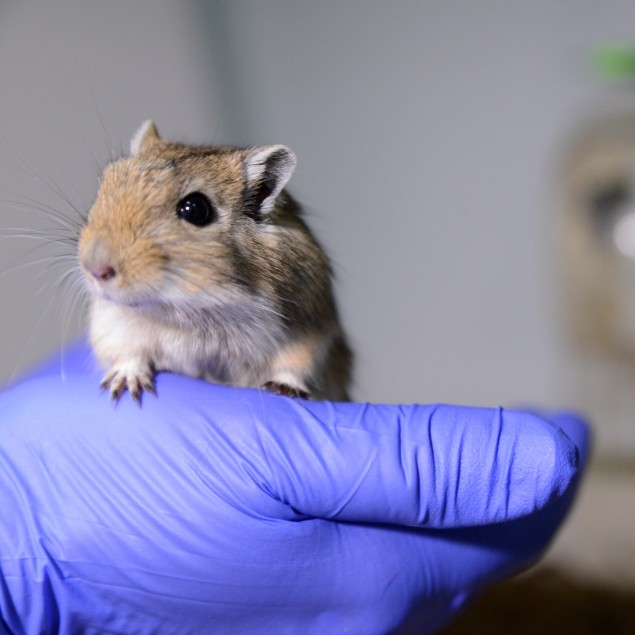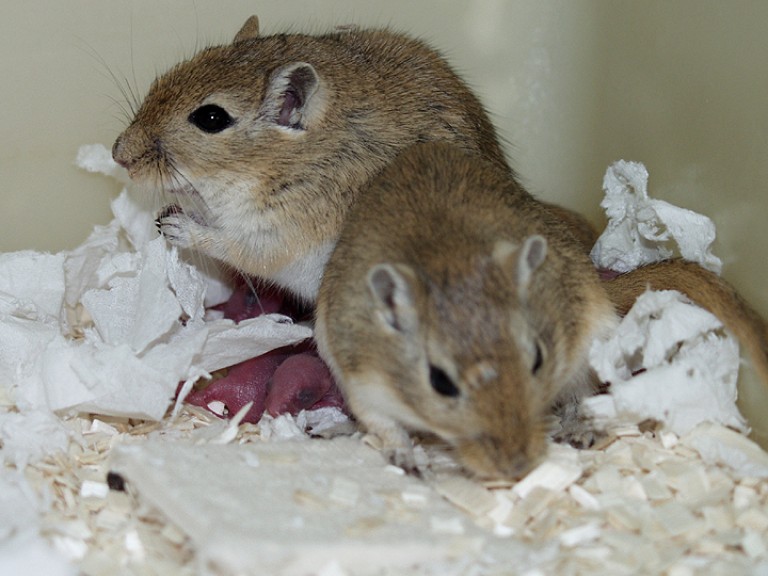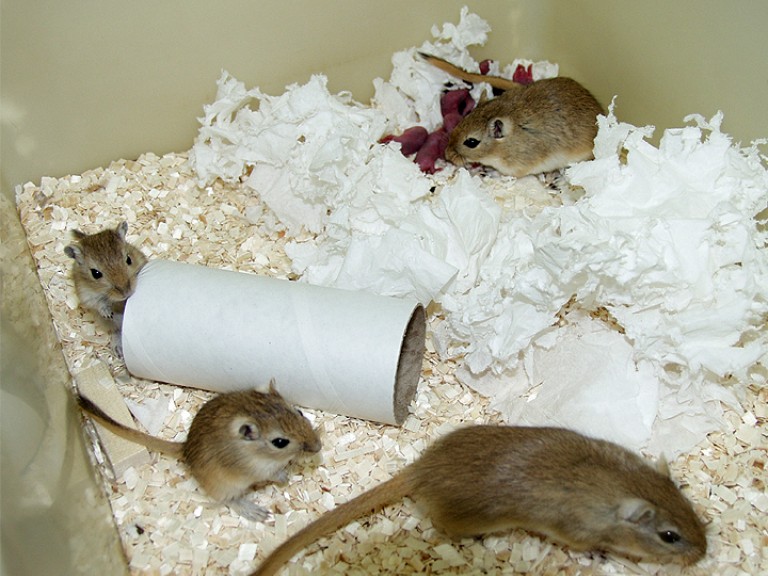Housing and husbandry: Gerbil
Information to help refine the housing and husbandry of the laboratory gerbil.
On this page
Introduction
The gerbil, or Mongolian jird (Meriones unguiculatus), is a social animal that communicates through olfactory cues, foot drumming and a broad range of vocalisations. Gerbils are active during the night and the day, but the peak of their activity levels occur at dawn and dusk. These rodents are highly motivated to dig and, if given the opportunity, will build extensive tunnel systems. Burrows are inhabited by a dominant, reproductive pair and their extended family, with offspring helping to rear their siblings.
Gerbils are considered relatively easy to handle and maintain in the laboratory, due to their generally non-aggressive and inquisitive nature. However, they are prone to stress-related seizures [1], so great care should be taken to limit the stress associated with handling and environmental disturbance, such as cage cleaning. Gerbils should be carefully habituated to regular handling as juveniles; treats can be used to positively reinforce contact with humans [2]. Gerbils should never be picked up by the tail, as this can result in degloving (‘tail slip’) [3].

Enclosures
Minimum enclosure sizes for gerbils in European research establishments are fully detailed in Table 1.3 of Annex III to Directive 2010/63/EU. The minimum enclosure size for adult gerbils is 1200 cm2, with a minimum floor area per gerbil of 150 – 250 cm2, depending on body weight. The minimum cage height is 18 cm, however the UK Home Office advises a minimum cage height of 20 cm.
The most common types of cages are conventional open-top cages and individually ventilated cages (IVCs). However, the standard bar spacing of open top cages (0.7 cm) can be too narrow for gerbils to access food from the hopper with ease, due to their relatively wider snout compared to mice and rats. To allow easy access to food hoppers, bars spacing of 0.9 – 1.2 cm should be sufficient. Inaccessible food hoppers can lead to aggression towards cage-mates when feeding, as food is perceived as a limited resource. Scattering food on the cage floor is a validated alternative to the use of a food hopper for gerbils [4].
As with all rodents, care should be taken to arrange the living area in a way that allows gerbils to compartmentalise their space. For example, water and food should be provided in one end of the cage leaving the other end free to be used for urination and defecation. Nesting material is essential to meet behavioural and thermal requirements [5,4]. Enrichment items should be provided in order to increase cage complexity and the available floor area, and to allow spatial compartmentalisation. Floors should be solid and covered with suitable substrate (e.g. rough-grained woodchip). Use of grid or wire mesh floors requires strong scientific justification and should be avoided as they can lead to injuries. If grids or wire mesh are used, a solid area should be provided for the animals to rest on (unless specific experimental conditions prevent this, authorised by the project licence).
Cage cleaning
Gerbils rely heavily on olfactory cues, including those from saliva, to communicate and gain information about the environment [7]. The removal of scent cues can cause stress; therefore, spot cleaning (the removal of soiled substrate and nesting material only) is preferable to replacing all the of the floor substrate and nest with clean material. When a full cage clean does take place, or animals are moved to a new cage, some old, clean nesting material should be retained. Gerbils are well-suited to extended cage-change intervals as they output a low volume of waste, which comprises of dry faeces and highly concentrated urine [8]. Gerbils are hoarders and will cache food by burying it within the cage.
Social housing
Gerbils live in groups of between two and 17 in the wild. It is not recommended to singly house this species, as isolation can elicit anxiety-and-depression-like behaviour [9,10]. In the laboratory, gerbils can be kept in family groups, breeding pairs or same-sex groups. In the case of the latter, it is important that these groups are established as juveniles (before seven to eight weeks) in order to prevent aggression [9,11]. Unlike mice, same-sex male groups are usually more harmonious that same-sex female groups [9].
Gerbils produce two litters a year in the wild but can reproduce year-round in captivity, with ovulation occurring 18 hours after birth [11] Males remain with the family group after their mate has given birth and provide significant parental care to offspring [12]. Separation of pair-bonded individuals results in negative welfare states and pregnancies can be lost. Aggression may occur upon reintroduction, between both bonded pairs and other group mates [9,11]. Juveniles that are separated from the family group before the birth of the next litter can develop stereotypic bar mouthing behaviour that cannot be addressed by the provision of enrichment items later in life [13].
Consideration should be given to minimising the disruption of communication between animals, in order to prevent stress and aggression within the group (see cage cleaning and lights and sound). When housed in stable groups, under appropriate conditions, aggression is uncommon. However, when it does occur it can be severe. Expulsion of group members from formerly stable groups is possible, and this is usually instigated by the pregnant or lactating, dominant female [9]. Gerbils are territorial and will attack unfamiliar individuals, with fatal consequences if separation does not occur [11].


Lights and sounds
Gerbil rooms typically have a 12-hour light-dark cycle. The behaviour of gerbils indicates that low-light areas are important to this species; a preference is shown for partially darkened cages [14]. and access to a darkened nest box prevents stereotypical behaviour [13]. It is therefore recommended that the light levels within cages are low, particularly for albino animals. It is possible that light-induced retinal damage is a lower risk for gerbils than it is for mice and rats as their visual system is well adapted to diurnal life [9]. However, research in this area is lacking and so a cautious approach should be taken.
Gerbils have a broader range of hearing than other laboratory rodents (0.1 – 50 kHz) [15] and are sensitive to both infrasound and ultrasound, which they use for communication (0.3 – 45 kHz) [16]. Anthropogenic (human-made) sources of infrasound include air conditioners, heavy machinery and wind turbines [17]. Sources of ultrasound in laboratories include dripping taps, trolley wheels and computer monitors. As some sources of noise disturbance cannot be eliminated (e.g. ultrasound from laboratory equipment), playing background music may help mask stressful sounds, as has been suggested for mice [18], although this has not been validated for gerbils. It is advisable to minimise sudden irregular noises as these can disrupt breeding behaviour and trigger epileptiform seizures (UK Home Office).
Temperature and humidity
UK Home Office guidance states that gerbil rooms should be maintained at a constant temperature between 20 – 24 °C. Gerbils have the widest thermoneutral zone reported among small mammals (26.5 – 38.9 °C) [19]. Nesting material is essential to allow gerbils to create microclimates within their cages [5,6].
Gerbils are sensitive to high relative humidity, which can cause dermatitis and a greasy, unkempt coat. In order to prevent health problems, it is recommended to keep gerbils at a relative humidity between 35 – 50 per cent. Steps can be taken to lower within-cage humidity, such as the provision of dry, absorbent bedding material (UK Home Office).
Environmental enrichment
Care should be taken when exposing gerbils to novelty, due to their pre-disposition to suffer stress-induced seizures [20]. However, appropriate environmental enrichment is essential for the healthy development and wellbeing of these animals [2,9,10].
In the laboratory gerbils commonly develop stereotypic digging behaviour, unless they are provided with adequate facilities for digging [2]. For this reason, gerbils need comparatively more space than other rodents in order to allow them to build and use burrows of sufficient size. They require a thick layer of litter for digging and nesting and/or a burrow substitute. An artificial burrow can be created by attaching a 5 cm diameter pipe, which may need to be ≥20 cm long, to a nest box. Using a pipe with an angle can save space within the cage and also prevents light from entering the artificial burrow. It is important that the burrow space is dark; transparent burrows fail to address stereotypic behaviour and have been observed to function instead as a latrine [2]. Access to a dark burrow is important for the healthy development of juveniles. Gerbils that are reared with access to a burrow are less likely to develop stereotypic digging behaviour later in life [10].
Gerbils prefer substrate to a bare cage floor and require access to rough surfaces to prevent the overgrowth of claws [11]. This can be achieved by the provision of a coarse substrate (e.g. rough-grained wood chip) and/or rough-surfaced objects (e.g. a stone, or an upturned bathroom tile) within the cage. Gerbils are strongly motivated to shred material and build nests; suitable items, such as cardboard or hay, should be provided to facilitate this behaviour [9]. Nesting materials that can be separated into thin strands, such as cotton wool, are unsuitable for gerbils and can pose a health risk. Gerbils need to gnaw in order to prevent the overgrowth of teeth, so gnaw blocks and chews should be provided.
Given their preference for partially darkened cages, shaded areas (opaque lids), tunnels and/or shelters should be provided to gerbils. Other species-appropriate forms of enrichment include scatter feeding of treats, such as sunflower seeds, and a sand or dust bath. When providing treats and scatter feeding ensure a sufficient quantity is provided to prevent competition between individuals. Gerbils are hoarders and food storing behaviour should be facilitated (e.g. by providing food pellets within the cage) [6].
Summary of key features of housing and husbandry
- Cages should be large enough to provide enough space for exercise and normal social behaviour, with a minimum height of 20 cm.
- Cages should be well ventilated, softly lit with shaded areas and subject to a light dark cycle. The relative humidity should be kept at 35 – 50 %.
- Gerbil rooms and cages should be kept at a temperature range of 20 – 24oC. Extraneous noise, and in particular ultrasound and sounds that may startle animals, should be kept to the minimum.
- The bars of food hoppers should be sufficiently spaced for gerbils to access food easily (0.9 – 1.2 cm bar spacing). Note that food hoppers designed for mice and rats may require modification. Another approach is scatter feeding, which also facilitates natural foraging behaviour.
- Gerbils should be socially-housed in stable groups with compatible cage mates, or as breeding pairs. Unrelated same-sex groups can live harmoniously if they are introduced as juveniles.
- Cage cleaning frequency should be kept to the minimum and nesting material should be transferred to clean cages to maintain familiar odours and minimise stress.
- Cages should have solid floors covered with an adequate depth (e.g. a minimum of 20 – 30 cm) of appropriate substrate for hygiene, comfort and to permit natural foraging and digging behaviour.
- Appropriate enrichment should be provided. Animals should have access to either a self-dug or artificial, burrow. It is important that it is dark inside the burrow.
- Appropriate and sufficient nesting material and substrate (e.g. a minimum of 20 – 30 cm depth) should be provided.
- Gnawing material and access to rough surfaces should be provided to avoid overgrown teeth and claws, respectively.
- The living area should be arranged in a way that allows gerbils to compartmentalise their space.
-
Gerbils should be habituated to handling as juveniles and should never be handled by the tail.
Related resources
- Home Office (2004). Mice, rats, gerbils, hamsters and guinea pigs. In: Code of Practice for the Housing and Care of Animals Bred, Supplied or Used for Scientific Purposes. Her Majesty’s Stationery Office.
- Waiblinger E (2002). Gerbils. In: Comfortable Quarters for Laboratory Animals (Eds. Reinhardt A, Reinhardt V). Animal Welfare Institute.
- Waiblinger E (2010). The laboratory gerbil. In: UFAW Handbook on the Care and Management of Laboratory Animals (Eds. Hubrecht RC and Kirkwood J). Wiley-Blackwell.
- Batchelder M, Keller LS, Sauer MB et al. (2012). Gerbils. In: The Laboratory Rabbit, Guinea Pig, Hamster, and Other Rodents (Eds. Suckow MA, Stevens KA and Wilson RP). Academic Press.
References
References
- Fenske M (1996). Dissociation of plasma and urinary steroid values after application of stressors, insulin, vasopressin, ACTH, or dexamethasone in the Mongolian gerbil. Experimental and Clinical Endocrinology and Diabetes 104(6): 441-446. doi: 10.1055/s-0029-1211482
- Waiblinger E and König B (2004). Refinement of gerbil housing and husbandry in the laboratory. ALTEX 32: 163-169. doi: 10.1177/026119290403201s27
- Kubiak M (2020). Mongolian Gerbils. In: Handbook of Exotic Pet Medicine (Ed. Kubiak M). 1st edition, John Wiley & Sons Ltd.
- Mulder GB et al. (2010). Method of feed presentation affects the growth of Mongolian gerbils (Meriones unguiculatus). Journal of the American Association of Laboratory Animal Science 49(1): 36-39. PMCID: PMC2824965
- Baumans V (2005). Environmental enrichment for laboratory rodents and rabbits: requirements of rodents, rabbits, and research. Ilar Journal 46(2): 162-170. doi: 10.1093/ilar.46.2.162
- FELASA (Federation of European Laboratory Animal Science Associations) (2006). Working Group Standardization of Enrichment, Working Group Report.
- Batchelder M et al. (2012). Gerbils. In: The Laboratory Rabbit, Guinea Pig, Hamster, and Other Rodents. Academic Press.
- McCullagh EA et al. (2017). Effects of an extended cage-change interval on ammonia levels and reproduction in mongolian gerbils (Meriones unguiculatus). Journal of the American Association of Laboratory Animal Science 56(6): 713-717. PMCID: PMC5710149
- Waiblinger E (2010). The laboratory gerbil. In: UFAW Handbook on the Care and Management of Laboratory Animals (Eds. Hubrecht RC and Kirkwood J). 8th edition. Wiley-Blackwell.
- Scheibler E and Waiblinger E (2018). Mongolian Gerbils (Meriones unguiculatus). In: Companion Animal Care and Welfare: The UFAW Companion Animal Handbook (Ed. Yeates J). 1st edition. John Wiley & Sons Ltd.
- Waiblinger E (2002). Gerbils. In: Comfortable Quarters for Laboratory Animals (Eds. Reinhardt A, Reinhardt V). 9th edition. Animal Welfare Institute.
- Elwood RW (1975). Paternal and maternal behaviour in the Mongolian gerbil. Animal Behaviour 23(4): 766-772. doi: 10.1016/0003-3472(75)90104-9
- Waiblinger E and König B (2007). Housing and husbandry conditions affect stereotypic behaviour in laboratory gerbils. ALTEX 24: 67-70. doi: 10.1177/026119290403201s27
- van den Broek FAR et al. (1995). Gerbils prefer partially darkened cages. Animal Welfare 4(2): 119–123.
- Engel J (2008). Gerbils can tune in. Journal of Physiology 586(4): 919. doi: 10.1113/jphysiol.2007.150409
- Ter-Mikaelian M, Yapa WB and Rübsamen R (2012). Vocal behavior of the Mongolian gerbil in a seminatural enclosure. Behaviour 149(5): 461-492. doi: 10.1163/156853912X639778
- Persinger MA (2014). Infrasound, human health, and adaptation: an integrative overview of recondite hazards in a complex environment. Nat Hazards 70(1): 501–525. doi: 10.1007/s11069-013-0827-3
- van Loo PLP and Baumans V (2015). Mice. In: Comfortable Quarters for Laboratory Animals (Eds. Liss C, Litwak K, Tilford D, Reinhardt V). 10th edition. Animal Welfare Institute.
- Shi Y and Wang D (2016). Implication of metabolomic profiles to wide thermoneutral zone in Mongolian gerbils (Meriones unguiculatus). Integrative Zoology 11(4): 282-94. doi: 10.1111/1749-4877.12179
- Thiessen DD et al. (1968). Spontaneous seizures in the Mongolian gerbil (Meriones unguiculatus). Psychonomic Science 11(7): 227–228. doi: 10.3758/BF03327673
